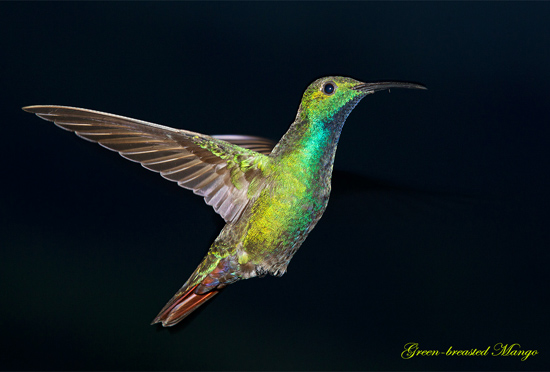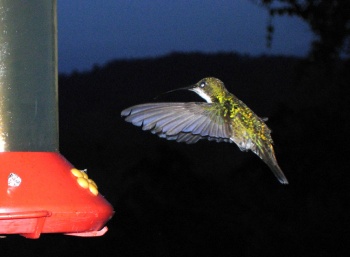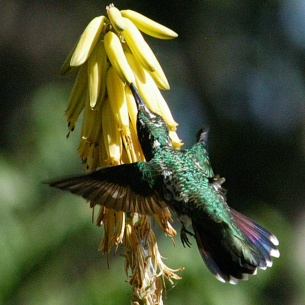- Anthracothorax prevostii
Identification
11–12 cm
Adult male: mostly green, maroon tail, black stripe with blue borders from throat through central breast.
Females differ in having white around the black stripe on underside, and in having white tip and a black subterminal band to tail.
Juvenile as female but with rufous between green and white on undersides.
Similar species
Replaced in Panama (Pacific side) by Veraguan Mango which differs by the central stripe being greenish-blue, not black.
Distribution
Central America and South America
Central America: Mexico, Guatemala, Belize, El Salvador, Honduras, Nicaragua, Costa Rica, and northwest Panama.
South America: Colombia, Venezuela
Seen as vagrant in the USA.
Taxonomy
Veraguan Mango has been split from this species
Subspecies
There are 5 subspecies[1]:
- A. p. prevostii :
- Eastern Mexico to Guatemala, Belize and El Salvador
- A. p. gracilirostris:
- El Salvador and Honduras south on the Pacific slope to central Costa Rica and on the Caribbean slope to northwestern Panama (Bocas del Toro).
- A. p. hendersoni (pinchoti):
- Isla Providéncia and Isla San Andrés (off east Nicaragua)
- A. p. viridicordatus:
The subspecies iridescens was recently transferred to Black-throated Mango.
Habitat
Midland forest and forest edges, banana and aloe vera plantations; open country, pasture.
Behaviour
Diet
Feeds on nectar and comes to feeders; will probably also catch insects as other Mango's.
References
- Clements, J. F., T. S. Schulenberg, M. J. Iliff, T. A. Fredericks, J. A. Gerbracht, D. Lepage, S. M. Billerman, B. L. Sullivan, and C. L. Wood. 2022. The eBird/Clements checklist of Birds of the World: v2022. Downloaded from https://www.birds.cornell.edu/clementschecklist/download/
- Gill, F, D Donsker, and P Rasmussen (Eds). 2022. IOC World Bird List (v 12.2) DRAFT. Doi 10.14344/IOC.ML.12.2. http://www.worldbirdnames.org/
- Avibase
- Ridgely & Gwynne 1989. Birds of Panama. Princeton Paperbacks. ISBN 0691025126
- Garrigues and Dean 2007. The birds of Costa Rica - a field guide. Cornell University Press. ISBN 978-0-8014-7373-9
Recommended Citation
- BirdForum Opus contributors. (2024) Green-breasted Mango. In: BirdForum, the forum for wild birds and birding. Retrieved 29 April 2024 from https://www.birdforum.net/opus/Green-breasted_Mango
External Links
GSearch checked for 2020 platform.






